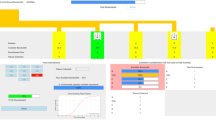Abstract
In this paper we discuss laboratory experiments that address the problem of self-governance in an asymmetric commons dilemma. Small-scale irrigation systems that provide food for hundreds of millions of people around the world are probably the most common example of such dilemmas. Here, we formulate an abstract dilemma in which subjects make both a decision about investment in the provision of infrastructure associated with the use of a resource and about how much to extract from the common-pool resource made available by this infrastructure. The impact of inherent asymmetry in irrigation systems on the provision of a resource and the impact of communication on the capacity of the group to solve the two-level commons dilemma of cooperation and coordination based on the analysis of the experimental data are discussed.
Similar content being viewed by others
References
Balliet, D. (2010). Communication and cooperation in social dilemmas: a meta-analytic review. The Journal of Conflict Resolution, 54, 39–57.
Bochet, O., Page, T., & Putterman, L. (2006). Communication and punishment in voluntary contribution experiments. Journal of Economic Behavior & Organization, 60(1), 11–26.
Budescu, D. V., & Au, W. T. (2002). A model of sequential effects in common pool resource dilemmas. Journal of Behavioral Decision Making, 15, 37–63.
Camerer, C. F., & Fehr, E. (2006). When does “Economic Man” dominate social behavior? Science, 311, 47–52.
Cifdaloz, O., Regmi, A., Anderies, J. M., & Rodriguez, A. A. (2010). Understanding robustness in small-scale social-ecological systems: the Pumpa Irrigation System in Nepal. Ecology and Society, 15(3), 39.
Croson, R. T. A., & Marks, M. B. (2000). Step returns in threshold public goods: a meta- and experimental analysis. Experimental Economics, 2(3), 239–259.
Fehr, E., & Gächter, S. (2000). Cooperation and punishment in public goods experiments. The American Economic Review, 90, 980–994.
Gneezy, U., Niederle, M., & Rustichini, A. (2003). Performance in competitive environments: gender differences. Quarterly Journal of Economics, 1049–1074.
Hackett, S., Schlager, E., & Walker, J. M. (1994). The role of communication in resolving commons dilemmas: experimental evidence with heterogeneous appropriators. Journal of Environmental Economics and Management, 27(2), 99–126.
Hunt, R. C. (1988). Size and structure of authority in canal irrigation systems. Journal of Anthropological Research, 44(4), 335–355.
Isaac, R. M., & Walker, J. M. (1988a). Group size effects in public goods provision: the voluntary contribution mechanism. The Quarterly Journal of Economics, 103, 179–200.
Isaac, R. M., & Walker, J. M. (1988b). Communication and free-riding behavior: the voluntary contributions mechanism. Economic Inquiry, 585–608.
Isaac, R. M., Walker, J. M., & Williams, A. W. (1994). Group size and the voluntary provision of public goods: experimental evidence utilizing large groups. Journal of Public Economics, 54(1), 1–36.
Janssen, M. A., Holahan, R., Lee, A., & Ostrom, E. (2010). Lab experiments to study social-ecological systems. Science, 328, 613–617.
Janssen, M. A., Bousquet, F., Cardenas, J. C., Castillo, D., & Worrapimphong, K. (2011). Field experiments on irrigation dilemmas (submitted).
Lansing, J. S. (1991). Priests and programmers: technologies of power in the engineered landscape of Bali. Princeton: Princeton University Press.
Ledyard, J. O. (1995). Public goods: a survey of experimental research. In J. Kagel & A. Roth (Eds.), The handbook of experimental economics (pp. 111–194). Princeton: Princeton University Press.
Ostrom, E. (1992). Crafting institutions for self-governing irrigation systems. San Francisco: ICS Press.
Ostrom, E., Walker, J. M., & Gardner, R. (1992). Convenants with and without a sword—self-governance is possible. The American Political Science Review, 86(2), 404–417.
Ostrom, E., & Gardner, R. (1993). Copying with asymmetries in the commons: self-governing irrigation systems can work. The Journal of Economic Perspectives, 7(4), 93–112.
Rabe-Hesketh, S., & Skrondal, A. (2008). Multilevel and longitudinal modeling using stata (2nd ed.). College Station: Stata Press.
Rapoport, A. (1997). Order of play in strategically equivalent games in extensive forms. International Journal of Game Theory, 26, 113–136.
Wittfogel, K. A. (1957). Oriental despotism: a comparative study of total power. New Haven: Yale University Press.
Author information
Authors and Affiliations
Corresponding author
Electronic Supplementary Material
Below is the link to the electronic supplementary material.
Rights and permissions
About this article
Cite this article
Janssen, M.A., Anderies, J.M. & Joshi, S.R. Coordination and cooperation in asymmetric commons dilemmas. Exp Econ 14, 547–566 (2011). https://doi.org/10.1007/s10683-011-9281-9
Received:
Accepted:
Published:
Issue Date:
DOI: https://doi.org/10.1007/s10683-011-9281-9




